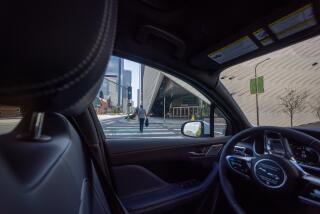Some pedestrians are more at risk crossing the street
- Share via
WASHINGTON — The elderly and those who have been drinking alcohol are the most likely to be struck and killed by a vehicle, according to the government’s most comprehensive report on pedestrian deaths.
There were 4,882 pedestrian deaths in 2001, about 12% of the 42,116 traffic deaths, the National Highway Traffic Safety Administration reported in a study released last week. That was a decrease of 16% from a decade earlier.
People 70 and older accounted for 18% of all pedestrian deaths in 2001, for a per-capita death rate nearly double the overall average.
Almost one-third of pedestrian victims and about 15% of drivers had a blood-alcohol content of at least 0.08%, the level at which many states consider a person intoxicated, according to the report.
The report shows that nearly 1 in 5 pedestrians killed in traffic accidents is a victim of a hit-and-run crash.
Young children also are at high risk. More than one-fifth of the children between the ages 5 and 9 killed in traffic accidents in 2001 were pedestrians. “Clearly, some of the most vulnerable members of our society -- the young and elderly -- are often the victims of serious pedestrian crashes. And the involvement of alcohol in many of these fatal crashes makes them especially senseless,” NHTSA Administrator Jeffrey Runge said.
Elly Martin, a spokeswoman for the agency, said the cause of pedestrian fatalities is complex. Factors include roadway design; availability of lighting, sidewalks or crosswalks; and enforcement of traffic laws.
Improvements in those areas helped reduce the number of fatalities in the last decade, she said. In Seattle, which reported the lowest rate of pedestrian fatalities among major cities, pedestrian safety has long been a priority.
In recent years, officials have begun a major effort to ticket drivers who fail to yield to pedestrians, said John Moffat, director of the Washington Traffic Safety Commission.
The city also has spent millions on traffic-calming devices such as small pedestrian traffic circles at intersections in residential neighborhoods. The traffic circles have cut overall accident rates drastically, Moffat said.
Among other findings in the report:
* Most pedestrian fatalities occurred in urban areas (69%), outside intersections (79%), in normal weather conditions (90%) and at night (64%).
* The chances of being killed vary significantly from state to state. New Mexico, Arizona and Florida had the highest fatality rates, and North Dakota, Iowa and Nebraska had the lowest rates, the report found. Among major cities, Detroit had the highest rate of pedestrian fatalities, and Seattle and Indianapolis had the lowest.
* About 18% of pedestrian fatalities occurred between midnight and 6 a.m., a figure far higher than researchers had expected. More people are likely to be drunk at that time, researchers said.
Jonathan Adkins, a spokesman for the Governors Highway Safety Assn., which represents states on highway safety issues, said there are ways to improve safety for pedestrians.
“Better lighting, better walkways, flashing lights at intersections can make a difference -- and education in schools,” he said.
States have less money than needed for these programs, Adkins said, because NHTSA and other federal agencies push them to focus almost exclusively on increasing use of seat belts and decreasing use of alcohol.
Although those issues are important, Adkins said, other factors also should be considered as part of an overall approach to safety.
“We can’t just focus on belts and booze and exclude everything else.”
More to Read
Sign up for Essential California
The most important California stories and recommendations in your inbox every morning.
You may occasionally receive promotional content from the Los Angeles Times.













